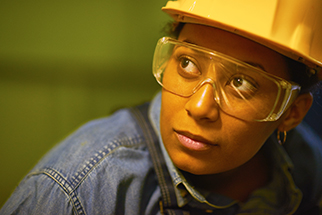On Oct. 29, 2018, we hosted more than 50 safety experts for a Women’s Workplace Safety Summit. During this daylong event in Rosemont, Ill., sponsored by Amazon, three breakout groups met to address the gender-specific issues related to workplace violence, PPE and leadership. Abby Ferri, CSP, facilitated the personal protective equipment (PPE) group.
This article is part two of a three-part series designed to help stakeholders better understand the purpose of the summit and how we and our partners are working to remove the gender-related barriers to success for women.
Learn more about the workplace violence group from facilitator Kelly Bernish, CSP, founding member of our Women in Safety Excellence (WISE) Common Interest Group.
Learn more about the women in leadership group from facilitator Pam Walaski, CSP, CHMM, ASSP director-at-large.
 As facilitator of the personal protective equipment (PPE) workgroup during the summit and part of the planning committee, my goal was to bring together safety and other industry experts to move forward the focus issues in a meaningful way. The summit provided an opportunity to discuss the three challenges in depth and begin to form solutions.
As facilitator of the personal protective equipment (PPE) workgroup during the summit and part of the planning committee, my goal was to bring together safety and other industry experts to move forward the focus issues in a meaningful way. The summit provided an opportunity to discuss the three challenges in depth and begin to form solutions.
Keynote speaker Cori Wong, Ph.D., assistant vice president for gender equity at Colorado State University, introduced the concept of “going to the margins of the margins” to address challenges. By doing this, she explained, we can identify solutions that have a positive impact on the larger workplace, not just those who need extra support.
The Right Fit Delivers the Best Protection
Within the context of PPE fit, going to the margins of the margins would mean considering, for example, women who are short and curvy, as well as men who may be shorter, taller, narrower or wider than average. A common theme in our discussions was that a broader range of sizes and cuts would benefit all people in the workplace.
I personally became aware of the PPE fit issue when I learned that some women, even safety professionals, modify their work equipment. Problems can arise when specific items of PPE, such as flame-resistant clothing, are modified because doing so can decrease or even eliminate the gear’s protective qualities. Ill-fitting PPE or work gear can also have a psychological effect on workers, causing them to feel unprotected. This may impact their productivity and potentially expose them to increased hazards.
Many of the size, cut and style options available on the market for women are not rooted in science. The “shrink and pink” phenomenon assumes that all women are petite and thin. People fall into a range of sizes and protective gear should reflect that reality. It also appears that many manufacturers do not understand the sizing of women’s apparel and gear. We heard several stories of enthusiastic vendors touting women’s gear that actually turned out to be sized for juniors or simply a smaller version of the standard men’s gear.
Identifying Next Steps
Our group finished the day with optimism, and identified numerous potential partners with whom we could work to solve the PPE fit challenge. Overall, we agreed that more data are needed to understand incidents that may be caused by ill-fitting PPE. The costs of customization and offering a broader range of sizes are common barriers that must be addressed with suppliers and those making purchasing decisions. We also contemplated how best to educate those involved in selecting and purchasing PPE, as well as those who manufacture the equipment.
Next-step activities include gathering data, developing universal fit guidelines, providing ratings and reviews of PPE and work gear, and publishing white papers and testimonials geared toward equipment users. ASSP is exploring the development of a technical report on PPE that would include guidance on selecting gear for different populations. In addition, ASSP plans to publish a report on the summit in early 2019. ASSP’s Women in Safety Excellence (WISE) Common Interest Group is sponsoring a collaboration session on the summit during Safety 2019, the Society’s annual professional development conference, next June. Please join us for what I’m sure will be an important discussion.
We are also committed to continuing the dialogue in the ASSP Community. Join our conversation and share your experiences with ill-fitting PPE or work gear, solutions tried and lessons learned. Simply log in using your ASSP.org username and password or create a new account. And on social media be sure to follow ASSP (Twitter, Facebook, LinkedIn) and WISE (Twitter, Facebook, LinkedIn) as we work to influence change around these important topics.
Understanding Risk Management and Assessment
We have the resources and expert guidance you need to improve how you assess risks to prevent hazards, protect workers and safeguard equipment.
Learn more